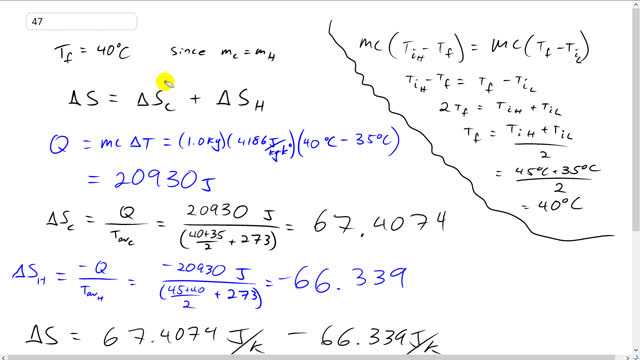
1.0 kg of water at is mixed with 1.0 kg of water at in a well-insulated container. Estimate the net change in entropy of the system.

In order to watch this solution you need to have a subscription.
This is Giancoli Answers with Mr. Dychko. The total entropy change of the system is going to equally change in entropy of the cold body of water plus the change in entropy of the hot body of water. C for cold, H for hot. And to calculate that, we need to know the amount of heat transferred and we have to divide it by the average temperature of the body of water. So, what is the final temperature of the system is the first question. The quick answer is that it's 40 degrees Celsius because both bodies of water have the same mass and the same specific heat. We can show it in more detail why that's the case and we can say that the heat loss by the hot body of water equals the heat gained by the cold body of water. hat's mass times specific heat times initial temperature of the hot body of water minus the final temperature, equals mass times specific heat times the final temperature minus the initial temperature or the low temperature body of water. But they have the same mass and the same specific heat so there's no subscripts on them and those are common factors you cancel on both sides. We have Ti H minus Tf equals Tf minus Ti L. And then the final temperatures can be collected on the same side. That makes it positive when you move it to the right side. And it becomes two times final temperature. And this term becomes positive when you move it to the left side. So we have two Tf equals Ti H plus Ti L. And then divide both sides by two and you get the final temperature. It turns out to be the arithmetic average of the initial temperatures of the high temperature and low temperature bodies of water. That's 45 less 35 over two is 40 degrees Celsius. So that helps us figure out the average temperature. And then the amount of heat transferred is of same magnitude for both bodies of water. The amount of heat gained by the cold water is the same as the amount of heat lost by the hot water. The only difference is that the cold water is a positive in front of the heat and the hot water is a negative because it's losing that much heat. The change in entropy of a cold water is the heat transferred 20,930 Joules which we got by going one kilogram times specific heat, 4,186 Joules per kilogram Kelvin, times the change in temperature 40 minus 35 for example. And that gives 20,930. So, 40 plus 35 over two is the average temperature of the cold body of water, add 273 to make it into Kelvin. This gives 67.4074 Joules per Kelvin is the change in entropy of the cold body of water. So it increases entropy. The hot body of water decreases entropy by 20,930 Joules divided by its average temperature of 45 plus 40, over two, plus 273, and lost 66.339 Joules per Kelvin. So the total change in entropy is the sum of those 67.4074 plus 66.339 Joules per Kelvin, which has a total change in entropy of 1.1 Joules per Kelvin.